Since I intend to carry on baking sourdough and post about it I wanted to make my own starter from scratch to make sure I was capable of producing it and show how easy it is. If I can…anyone can produce some. For a sourdough novice like me when I first received my hand-me-down leaven I was expecting to be dealing with something incredibly difficult, something temperamental, something that’s always on the edge of dying. When I made room for this living thing on my kitchen top I was convinced it was going to be my worst child to look after. The words volatile, unstable, neurotic, fiery, highly-strung, sensitive, irritable, came to mind...urmmmm..but enough about me now….For those of you who have Dan’s starter I’m sure will agree it’s incredibly easy to make and to maintain. I was led to believe this organism was hellish, it doesn’t help the vivid words still imprinted in my brain from reading Anthony Bourdain’s Kitchen Confidential where he describes his unreliable but amazing breadmaker ringing him after another absence to say “…feed the bitch…feed the bitch”.
I follow just a couple of simple rules, always use cold water, always put it in very clean containers, make sure nothing contaminates it, I only use clean spoons to divide it up, I have no idea if these are essential but it’s my method and it seems to be just fine on it. I’ve read people having problems with creating starters but they were referring to starter just using flour and water, Dan uses raisins and tiny bit of yoghurt. Dan states in his Handmade Loaf book there is a high chance of yeast being on the surface of raisins and the yoghurt contains lactic bacteria, lactobacilli which is responsible according to wikipedia for the sour taste.

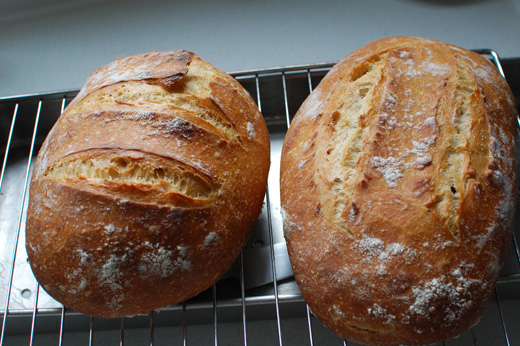
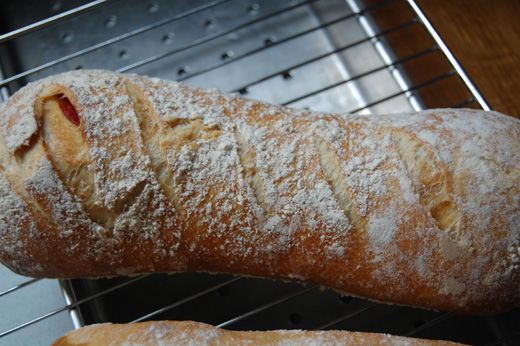
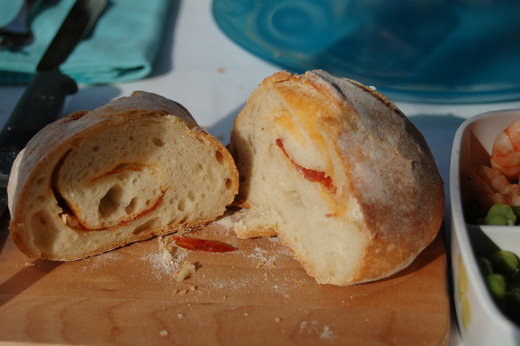
I mess up the recipe…but it still worked.
I had read through the instructions fully carefully before starting the process but when day 4 came to throw away three quarters of the mixture before feeding it with fresh flour and water I forgot…what can I say…I was distracted…it had been a long day…I also forgot to remove the raisins too. I was hoping it wouldn’t be the end of its world since I was feeding new flour to keep it ticking away and I was right it did just fine. I’m giving you the correct method as Dan has it but realise my photos of the process will be distorted somewhat, they should look lame in comparison to the right way. I think subconsciously I do this kinda of thing wrong on purpose, that way I can prove even the most absent minded of us can produce the illusive Sourdough Starter!
By the way, if it so happens you make the foolish mistake of mine of just adding flour without taking some old mixture out first (day 4 onwards) then once you’ve added the fresh flour and water remember to remove some of the mixture and throw it away….otherwise you won’t have room in the jar if you keep on adding but not taking away…yes…I had a Homer Simpson moment there!
Now realise I’m a novice at all this sourdough…I can produce a good white loaf or even a brown loaf but when it comes to reducing the hydration percentages of your starter or other such stuff I’m still a newly wed bride here, there is good help on Dan’s website if you head to the forum section and just post your question, the help may be a little slow but it’s friendly and experienced folks on there will help. My starter is kept at 100% hydration; whatever the amount of starter I feed it with double the amount of water and flour, easy to remember.
Water Temperature 20˚C
The water for whole process should be at this temperature but I just did not have a thermometer that would take a low enough temperature, my sugar thermometer starts at 40˚C. Instead I relied on using the temperature I use when making a sourdough bread, water that is cold to the touch, not freezing cold but the coldness you would find if you left water at room temperature.
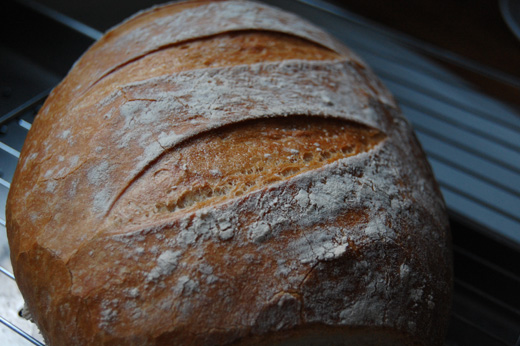
Jar Size
Use a 500ml jar, Dan suggests to use a kilner jar but all I had was my very large 1 pint jam jar. I filled it with 500ml of water and could see there was plenty of room for the mixture to bubble up.
Day 1
- 50g water 20˚C
- 2 rounded teaspoons of rye flour
- 2 rounded teaspoons of strong white flour
- 2 rounded teaspoons of currants or raisins
- 2 rounded teaspoons of live low-fat yoghurt (I don’t think mine was low fat, couldn’t find any so grab a plain activa)
Mix everything together tighten with lid and leave for 24 hrs
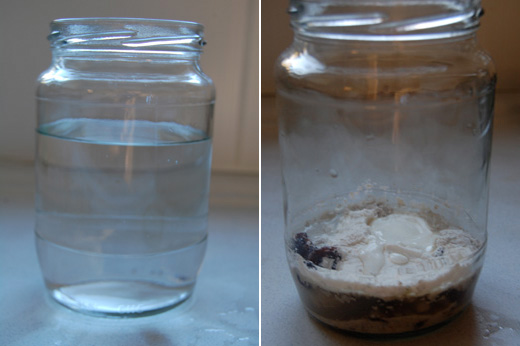
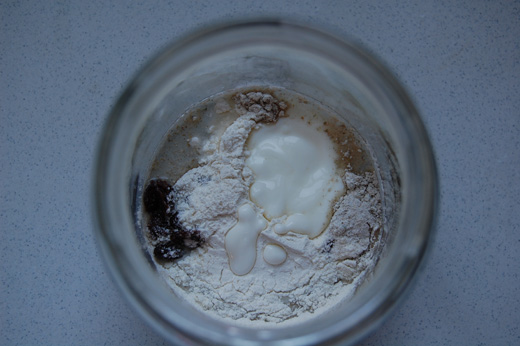
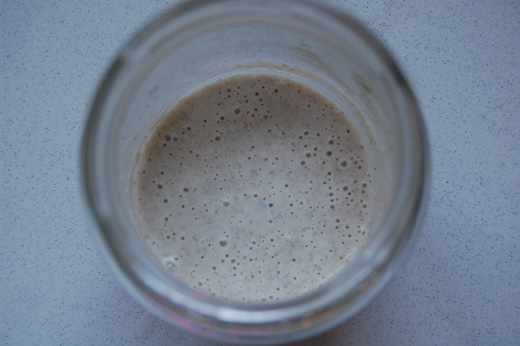
DAY 2
- 50g water 20˚C
- 2 rounded teaspoon rye flour
- 2 rounded teaspoon strong white flour
Add the water first and then the flours mix well and leave for 24 hours.

DAY 3
I was interested to see by now a few bubbles appearing on the surface.
- 100g water 20˚C
- 4 rounded teaspoons rye flour
- 4 rounded teaspoons strong white flour
Add the water followed by the flours mix well and leave it for 24 hrs.


DAY 4
- 100g water 20˚C
- 125g strong white flour
Before adding water and flour make sure you first remove three quarters of the mixture and throw it away. Strain the raisins or currants from the remainder quarter and put the mixture back into the jar and then add the water and flour! Yes….this is where I went a little wrong…doh!

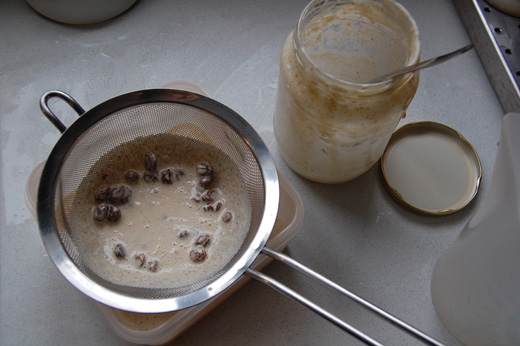

DAY 5
- 100g water 20˚C
- 125g strong white flour
Now this where my photos don’t match your starter because you should have more bubbles bubbling away…but I could tell there was something going on here with tiny little bubbles.
Again like day 4, first throw away three quarters of this old mixture and then add the water followed by the flour mix well, leave for 24 hrs.
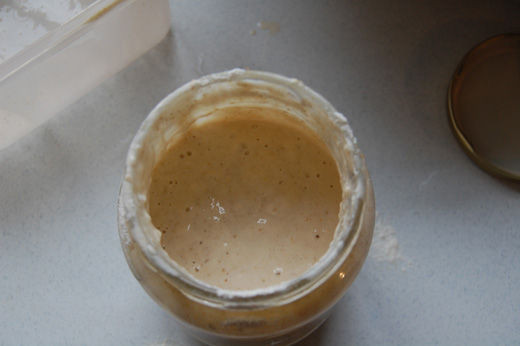
DAY 6
This is it now you should have a nice bubbling mixture. Mine here is lagging behind because I kept forgetting to remove old mixture before adding fresh flour and water, but it was still active.
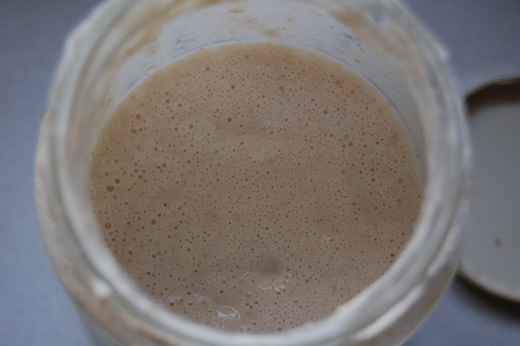
Still On Day 6
- 50g of my new starter
- 100g water 20˚C
- 100g strong white flour
Put all of the above into a clean container large enough for some bubbling expansion, and leave it for 24 hrs.
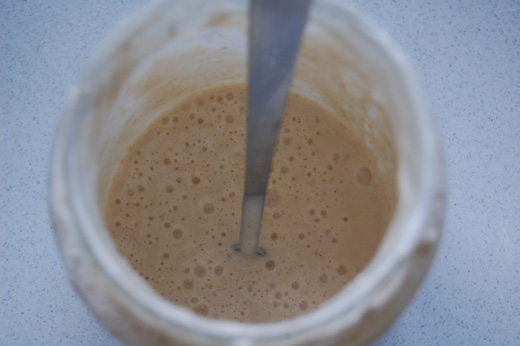
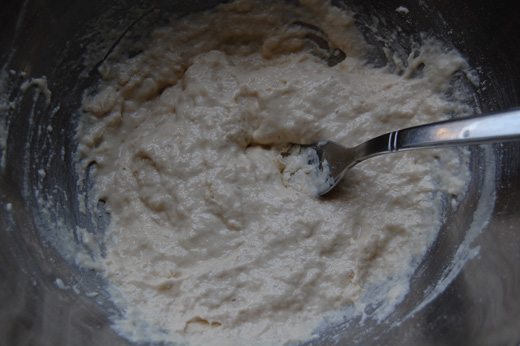
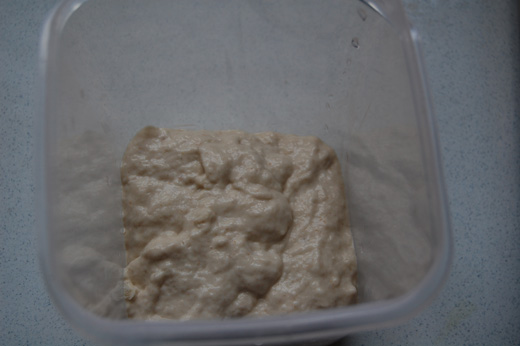
DAY 7
And here is the proof my new starter in the small container (right) is not far from my hand-me-down starter (left)
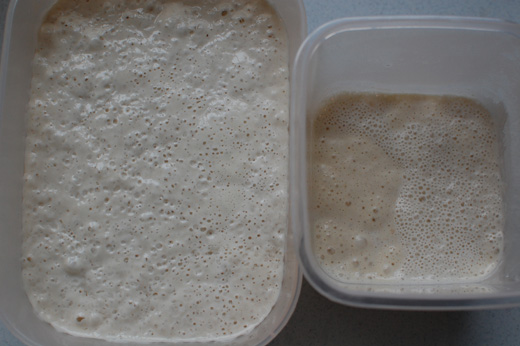
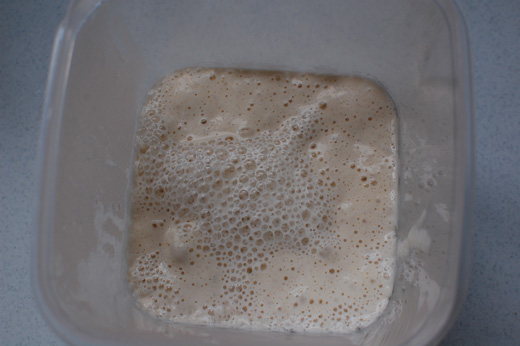
From Now Onwards
- 100g starter
- 200g water 20˚C water
- 200g flour
I use the above ratio for my baking. This gives me 200g of leaven for say a white sourdough and just over a 100g for either a semi-sourdough or some pitta breads or a slow proving bread…whatever I’m doing And still having a 100g of starter to feed again for another batch of baking. If you don’t bake that often you can keep it in the fridge, leave it out after feeding. The mixture being colder I suspect will take longer to start bubbling away. For safe keeping I have 100g of starter in the freezer which apparently can stay there for a year.
I leave my starter on my kitchen worktop and then refresh every week to the above mixture. I didn’t realise in the beginning that the best time to use this leaven was between 8 hrs – 24 hrs after feeding, there should be lots of nice bubbles and the mixture should be gluppy. I have used leaven that is 3 days old but don’t expect the rise to be as good. When I’ve been stuck, forgotten to refresh the leaven for baking and I’m desperate for a loaf I’ve used the 3 day old leaven, but I add 2g of fast dried yeast to make sure it rises…your leaven will have a sourer smell and produce a slightly sourer bread.




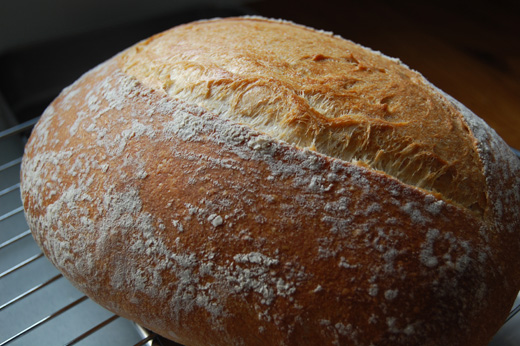



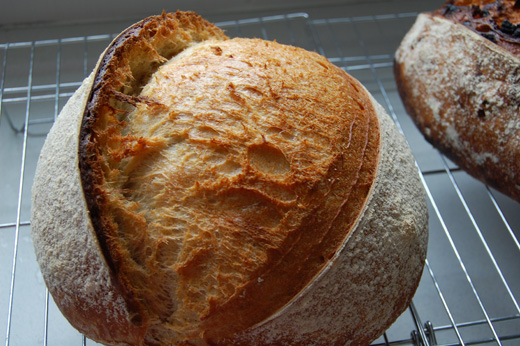

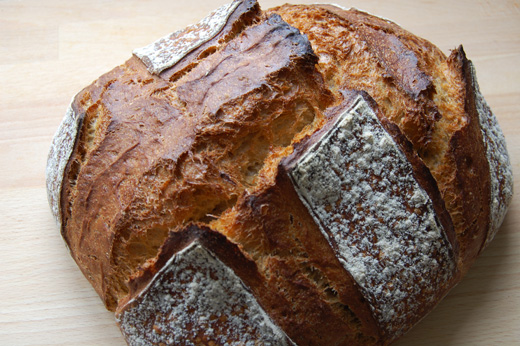



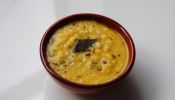


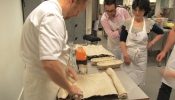














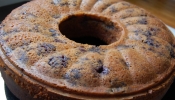


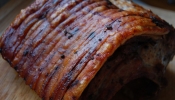

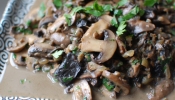

{ 36 comments… read them below or add one }
Wow-these look amazing. Thanks for all the helpful tips (rules).
Wow, that bread looks amazing. I’m envious!
After many years of working with sourdough, I’m convinced that it’s harder to kill a healthy starter than most think! There’s a brewery in California (US) that brought back to life a dormant bacteria from a piece of amber (petrified tree sap) that was several billion years old – and they are now using it (a close relative of a bread yeast) to make beer – proof positive that we’ll die before our sourdough starters do.
Nice blog.
Hi drgugawe – thank you and thank you for that story, it has cheered me up tonight…yes you’re right they will live on after us!
After reading your comments about the starter, I remain confused as to how often and how much to refresh the starter after removing some for baking. Is it necessary to refresh every day? If I remove 200g for baking, how much flour and water do I add back to remainder? I’m sorry, this is my first experience using a natural starter and I don’t want to destroy my newly created leaven! Thank you so much……I love your website.
hi beagybull – I refresh my starter once a week. You can have it in the fridge for up to two weeks. So you don’t have to feed it everyday.
People have different methods of using their starter, some have the starter (“mother starter” lets call it) and then if baking a lot they will take a small amount of it depending what the recipe requires, for example 25g starter feed it 50g water and 50g flour, feed that little piece overnight to use it the next day, that way they are only feeding what they need. The “mother starter” is still there as you left ready for more to be taken and be fed again. The “mother starter” can then be refreshed as you see it running out.
If you are worried about running out keep some in the freezer, I have 100g of starter in the freezer.
Azelia……thank you so much for the clarification……..the fog has lifted!
I did make Dan’s starter a few years ago using the raisins and I’m about to make it again using raisins, although I did make one using organic grapes. I will also use spring water out of a bottle, rather than use chlorinated water from the tap. Seeing your photos, Azélia has spurred me on to get going again!
What a fascinating story, drfugawe, about bringing the dormant bacteria back to life!
You’ll being baking sourdough again in no time Renée…that lovely crust crunching as you cut it…never fails to excite me!
Good morning Azelia. I hope you do not mind me writing to you, but I have been reading your fantastic blog now for a while – it is so interesting, and you are very kind giving so much help to us out here.
I have also been reading some of the entries on the BBC forum, a friend of mine joined a while ago, but I am not sure that I will. I looked at it ages ago before it had changed, now it does not seem as friendly. But we will see. i am very interested in making bread – particulary sourdough!! I have been given a starter that came from Tom Baker who runs Loaf in Birmingham. I am hoping to do his course, but again I will see how I get on myself. Your semi sourdough seems a good place to start really, because to be quite frank, I am not sure I totally like the taste of sourdough – at least not what I have bought in the past.
I noticed that you have later postings about bread than the semi one. Is the recipe still one the one that you use please? Does ‘middle daughter’ still like it?? What amazing children you have!
I apologise if I am not allowed to contact you like this, but short of joining the BBC forum, I found this way.
I am sure you are a very busy lady – you do so much! i just go to work part time and bake!! So please do not worry if you cannot answer me very quickly. Sourdough is very sedate and slow anyway!!PS fascinating information re the starter…. oh dear – I could spend all day – every day – learning about it!
Thank you very much
Jenny Jenkins
hi Jenny – thanks for making contact and I’m sure I can give you some guidance with sourdough through my own battles with getting to grips with it. I’m a novice at the sourdough game which means I like to keep things simple.
I need to know how you are feeding your starter? I feed my 1:2, so 100g starter and add 200g water and 200g flour. I’m assuming it’s a white sourdough starter?
A semi-sourdough has the advantage of giving a normal loaf flavour but still give a texture and taste less of a sourdough! There are sourdough bakers who would think adding a touch of baker’s yeast is sacrilege! But I say people should eat what they enjoy and a semi-sourdough is an excellent halfway-home to eating good bread.
What would you like help with? I can give you the recipe which I’ve got already on the blog or some guidance to the baking or proving but you need to let me know what help you need?
Hi Azelia, thank you so much for getting back to me. I feel very mean however, because I am riding on your back, utilising your experiences re this! In the past I have had disasters with bread, and I need to have a success to spur me on…. Right then – here goes …. I have read with great interest and several times all the articles you have so kindly written about your different types of bread, and I thought I read somewhere – but dont know where now, that you decided to use more water than the 280g cool water? Also that you did not use floured boards so prolifically (if that is the correct word) now – more like oiled boards or water …and that you now used the Dan Lepard method of folding every 10 mins…. !!! Maybe I am confusing myself – and just not getting on with it?? So to get your lovely looking (mmmm can almost smell them) semi sourdough – what a joy – a bit of yeast …. I am struggling to trust I suppose that no kneaded bread produces your fab loaves!! I know it is only flour and water – …. Also, do you make a habit of cooking straight from the fridge – I know you said that when you did it was a little damp and you should have cooked it for longer – how much longer do you think? i lilke that idea of cooking straight from fridge!
If you can make sense of what I am writing, and you are still here with me I am so grateful!
thank you so very much.
Jen
Sorry Azelia, in my eagerness to reply I forgot to tell you what you needed to know re my starter. I have several little pots believe it or not!! Waiting for me to do something with them – they both came from Loaf, Tom Baker, and look lively enough …. one I feed like you mentioned …. 10g starter, 20g flour and 20g water. The other which is Tom’s preferred way, dont know why, is 10g starter, 10g flour and 12.5g warm water!! So many different ways …. so worrying when you are a novice! Thanks.
hi Jenny – It sounds like you’ve done too much reading and not enough practice perhaps?
Here’s what I’ve noticed about bakers of sourdoughs…they all have slightly different ways of doing things and I can drive myself mad trying to understand and keep up with the slight different styles, so I stick to doing one bread type following one recipe really well for a long while until I feel I can do it in my sleep.
My advice is to stick to the starter you have the ratio of 1:2 like mine, choose a simple sourdough and if you want follow the semi-sourdough …and do it for the minimum of 10 times, until you know that recipe and loaf inside out. Then move on to a variation of it and build up your experience of sourdough slowly.
At some point you’re going to have to just do what the Nike Ad says and “Just Do It”…but not the once or twice at least 10 times…get to feel the changes in the dough…the length of the rises..the timings in your oven…and if it helps keep a diary of it so you can track what you did different…if you have done anything different.
The more you read the more you can get confused…the trouble with following too many different methods without first getting to grips with one loaf is you ended up in a muddle. Practice, practice and practice some more.
When I first started on sourdough it took loaf 4 or 5 until I was really happy but I carried on doing the same loaf and now months later I’m practicing shaping into batons but all this time I’ve just been playing with my white sourdough in-between making variations of it. There is no magic to this…but the more you have hand-on experience the more you learn, it’s in the doing that I learned all my experience. Good luck.
Thank you very much. I know you are right – it is just I am a bit scared if i am honest. But at worst it is just a bit of flour and water! OK – I will start with your semi sourdough – I will I will I will. You have given me very good advice. And I will come back and let you know how I am doing.
Thank you.
Hi Azelia,
I’m afraid it’s taken me an awful long time to get in touch. It was lovely to see you again last month (or was it the month before?) back in Langdon Park Road after all these years. And congratulations on your lovely wedding.
I’ve been following your blog for some time now, and your recipes are great but I wanted to wait to post until I could say I had produced a successful sourdough loaf. But now I realise that could be a while. My problem seems to be that my starter is not powerful enough, if that makes any sense. I mean it bubbles, but it doesn’t seem to have enough muscle to make a proper rise, no matter how much folding I do. So I produced a couple of bricks (quite tasty bricks) and at the third attempt I did a semi-sourdough which rose OK but didn’t have that wonderful chewy texture that I associate with the real thing. So I am just going to persevere (unless you can think of something I’m doing wrong…) and if the next few tries are no better I may ditch the starter and start again.
But I’m enjoying the experience, so thank you for putting me onto it.
Mary
hi Mary – Nice to see you again…and it was great to catch up after not seeing each other for so many years!
In order to try and figure out what’s going on with your starter I need to know more detail.
Did you follow Dan’s starter I have on this post?
What flour do you use to feed it? What’s the protein content on it? It will say on the side of packet.
When you feed your starter do you take some of the old starter to feed and throw the rest away?
When you feed your starter to use in dough recipe, how long after feeding do you wait to add it to the recipe?
What does it smell like?
How often do you feed the starter?
We’ll resolve it but just need to know what your routine is to help.
Hi Azelia,
Well life is funny sometimes. I was just about to reply to you this morning when I went down to the kitchen and discovered that my previously very lethargic levain had GONE MAD. It had doubled in size and looked like thick milkshake. I was so excited that I had to make a loaf straightaway and it was great. Didn’t look quite as good as yours but good texture and taste and a lovely crunchy crust. What more can you ask for?
All that I can think of that was different this time was that I had waited 9 days before feeding it and about 48 hours later it sprang into life. Maybe it needed to be good and hungry! So now I know that I have a living starter and it works, which is fantastic!
So, lots of thanks to you.
Mary
hi Mary – once fed use it in a recipe between 8-24hrs depending what time of year, in the winter 24hrs I found was average in my cold kitchen…right now 12-16hrs is about the time I use it and it’s very lively I can see the bubbles bursting in front of me.
Hi Azelia
I managed to kill the starter I was given to bring home after a day on sourdough bakery – even though it is supposed to be difficult. I’ve also had several unsuccessful attempts at getting some going using rye which I was told produced the most vigorous starter. We like sourdough so much that I’m giving it a go again using your instructions and keeping my fingers crossed. I used Dan Lepard’s no kneed method at the class and subsequently and it works so well and makes life so easy. Thank you for your clear instructions, and for sharing your trials and tribulations – so nice to know others made mistakes too.
Dear Azelia: Following your recipe, I am now at the stage where it dutifully cycles through from volcanic to frothy bubbles in 12 hours. Should I now leave it alone for a few days? I am at the point where I will try to make a loaf of bread! (Hurry, before I loose my nerve!). Shall I feed some of it according to a recipe? I am confused about when to feed if I am getting ready for a loaf of bread-0800 in the morning will put it at about 1800 in the evening and I do not want to be baking bread at that time. On the other hand, if I feed the starter at midnight it will be read to go at 0800 in the morning-I am not ready to bake bread then either! If my starter is frothy in 12 hours, then we can assume it should have been fed again approximately 2 hours earlier right-maybe midnight? What is your time schedule? Thank you again. Anne
Anne will come back and answer properly.
YAY!!!! I know this is a rather old post. I’m so happy I could spit gold coins (although it would be good trick and financially rewarding). I have been trying to get a starter going for a couple of weeks now. At first with a different recipe, now with yours (or rather Dan’s) without a whole lot of luck. Today I finally have bubbles!!!!! Thank you!
Be patient that’s all it takes Bonnie.
Hello Azélia,
Dear me oh my! I´ve followed to the letter Dan´s recipe for starter, made two slightly flat breads, but my starter simply doesn´t froth, nor rise. As I see above one of your forum friends says hers all of a sudden came to life-which I´m hoping for, but what would you say to adding some dried SanFrancisco starter a friend gave me, to my mix? Or should I simply throw out my flat stuff and start all over? I hate to kill a live being, however lethargic it may be!
many thanks for answering,
Patsy
Patsy
how many days since you started?
what yoghurt you used give me brand, want to check something.
what’s the temperature in your room?
Wow! You sure got back to me fast! I actually followed his instructions to a T-on the 6th day took out what looked like hardly bubbling leaven to make the first recipe he lists. This from “The Homemade Loaf”, which my daughter gave me for my birthday. I even bought some organic rye flour, and used high gluten “strong” flour. As far as the yoghurt goes,I used a Spanish store brand, regular full fat natural-no sugar.I think it could be the temp, as here, in the Canary Islands we don´t usually heat our houses, and inside now it rarely gets above 18º-19º.
Patsy
I´ll check in with you tomorrow, as I want to go chill in front of the tube. No rush, but my basic question would be can I use whole grain flour from the first if I add a tsp or two of gluten? I realize this is the reduced ingredient in most white flours, and I miss the texture and vitamins using only white.
Patsy I’m not not what you’re asking with the gluten, but don’t add gluten to your starter or your loaf.
It sounds as if your starter is not ready with enough yeast in it to produce a loaf, have a look at this post and tell me how much activity (bubbling) it has? http://www.azeliaskitchen.net/blog/life-cycle-of-a-sourdough-starter-part-ii/
To feed your starter swap the high gluten flour for a whole grain one, it will help with the natural sugars in wholemeal for yeast and bacteria to feed on.
Hey Azélia,
This link to your article has been a real eye-opener for me. I´m biding my time, leaving the SanFran starter to do it´s bit, as I added it yesterday to my failed leaven with some whole grain rye. The starter came in a dry format, so I might give it a little feed tomorrow am, but, as Dan answered me, sounds like I had no yeast, just bacteria, and I think he was right.
Will keep you posted.
Patsy
Hi again Azélia,
OK, today there were a few little bubbles from my beginners leaven with the SanFrancisco starter I added two days ago. The package said add 2 cups flour, one cup water and leave 1.5-3 days. I´ve just added(fed) with almost one cup flour-whole wheat per your instructions, plus 1/2 cup water. Will wait to see exactly what happens tomorrow, next day, and just might try baking with some, adding a tsp or two of regular yeast. I can see the SF yeast has come alive, so from now on, it seems to be more a case of patience ´til I see that goopy, thick leaven you show on your step-by-step.
Many thanks, Patsy
Hi Azelia! Thanks for the very helpful article! Its nice to hear the stories of others’ attempts! I am currently on my second attempt to create sourdough starter, and I too did not remove raisins, not because I forgot, but in all the mixing I did, they got so well diced up that they are in small bits all over! As I threw away my first attempt for nothing (forgot to feed on Day 4 and thought it was gone so threw it out without thinking), I am keen not to waste another batch if possible, and all the flour that has gone into it! It doesn’t seem to smell funny or bad, just yeasty and a bit like wine actually. What I was wondering is whether you continued using your starter with the raisins, and if not, whether you have any idea whether the raisins remaining present will affect the starter? Thanks a lot!
Hi Rudy – just remove the raisins they are not needed. I’m in the middle of writing a sourdough ebook on starters and will fully explain what goes on in the beginning of the starters and why the raisins are not necessary. You can read a little bit more about the idea behind the book in my post here, http://www.azeliaskitchen.net/blog/writing-an-ebook-on-sourdough-part-one-starters/
Hi Azelia, sorry to keep pestering you. On twitter you suggested replacing the water in this starte with Pineapple juice. Can I just check…did you mean just the initial water in the refreshment as well ? If the pineapple juice is going to lower the Ph enough to stop the bacteria then is it still necessary to add the yoghurt or is that in there for the Lactobacilli ?
Thanks
Campbell – either do the yoghurt OR the pineapple juice.
Doh! (no pun intended) Thanks
{ 4 trackbacks }